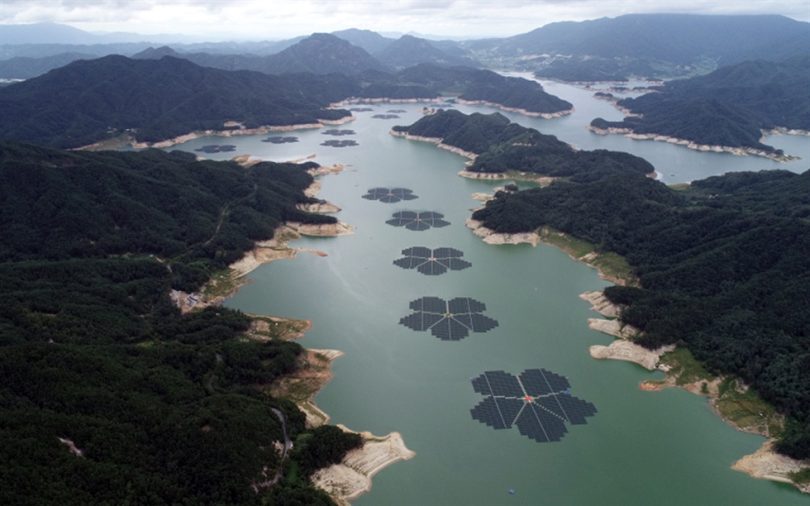[ad_1]
January. 7. 2022
Settings
2022-01-07 15:53
Renewable energy output 4.8 GW in 2021, surpasses national goal once more
 |
| Floating solar panels near Hapcheon Dam in South Gyeongsang Province’s Hapcheon County with 41 megawatts capacity started operating in November 2021. Courtesy of the Ministry of Environment |
By Ko Dong-hwan
Korea’s total renewable energy output in 2021 was 4.8 gigawatts (GW), surpassing the national goal by 0.2 GW, the Ministry of Trade, Industry and Energy said, Jan. 5.
Solar power contributed to most of the clean power last year, with 4.4 GW generated. Wind turbines contributed with 0.1 GW, while biomass and other renewable sources grew to 0.3 GW.
The accomplishment marks 2021 as the fourth consecutive year when national renewable energy output surpassed annual goals since 2018, a year before when the country launched its Renewable Energy 3020 Plan ― boosting renewable sources-based output to 20 percent of the country’s overall power generation by 2030.
As of last year, the country’s accumulated renewable energy output had reached almost 29 GW, out of which solar accounted for 21 GW and wind 1.7 GW. The 3020 plan targets raising the accumulated renewable energy output to 64 GW.
In the four years since the launch of the 3020 plan, the country saw 18.2 GW of clean power from newly-built renewable energy facilities. Among the figure, solar accounted for 15.6 GW, which is 2.4 times that from 2017 when accumulated solar energy had reached 6.4 GW.
The ministry said industrial renewable energy output’s contribution to the country’s overall power grid reached 6.5 percent as of October 2021, a two-fold increase from 2017.
 |
| Wind turbines on top of Mt. Cheongok in Pyeongchang County, Gangwon Province / Korea Times file |
Overall renewable energy output in 2021, however, fell short of that from 2020 when it was 5.3 GW ― the highest since the 3020 plan’s introduction. The shortage, according to the ministry, was largely because the country last year enforced stronger legal conditions for construction of solar panel farms in mountainous regions ― a longer distance between solar panels and closest residential villages to accommodate the residents’ comfort, and lowering a standard gradient for a solar panel site from 25 degrees to 15 to prevent landslides caused by the panels. The stronger measures resulted in reducing the national solar power output from 1.2 GW in 2020 to 0.8 GW the following year.
Difficulties people experienced in operating wind farms also caused the year-on drop of renewable energy output in 2021. The ministry noted that getting a license was too complicated ― there are 10 government bureaus involved in the process and 29 related laws that must be observed ― and setting up facilities often caused clashes with locals, causing delays to many projects. “It takes about three to four years to acquire a wind power operation license in countries with advanced wind power generation,” said a ministry official. “In Korea, it takes up to six years.”
Despite the challenges, the number of new wind power farms under construction increased from 4 in 2020 (capacity 120 megawatts) to 13 the following year (capacity 902 megawatts). It was because the country raised wind power’s renewable energy certificate (REC) value from 1.0 in 2020 to 1.2 the following year, improving wind power’s profitability to drive the energy type’s broader expansion nationwide.
To further increase the national renewable energy output, the government plans to expand renewable portfolio standards (RPS) ― a mandate for power generators to increase energy production from renewable sources instead of fossil and nuclear ― by raising its mandatory minimum rate from 10 to 12.5 percent. New wind power laws this year will also lower a legal bar to install wind turbines, while new regulations to better accommodate residents near renewable power stations with better incentives are also coming soon.
[ad_2]
Source link










